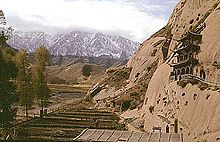Matisi grottoes
| Tibetan name |
|---|
|
Wylie transliteration : rta poor dgon
|
The Matisi Grottoes ( Chinese 马蹄寺石窟群 , Pinyin Mǎtísì Shíkūqún ) are Buddhist cave temple on the west bank of the Mati River (马蹄河Mǎtíhé) on the administrative territory of the municipality of Mati of Tibetans (马蹄藏族乡Mǎtí Zàngzúxiāng) Autonomous County Sunan of Yugur ( 肃南 裕固族 自治县 , Sùnán Yùgùzú zìzhìxiàn ), which belongs to the district-free city of Zhangye in the Chinese province of Gansu .
The Matisi Grottoes have been on the list of monuments of the People's Republic of China in Gansu since 1996 .
size
It is a larger group of different cave complexes that are scattered over dozens of kilometers in the northern foothills of the Qilian Mountains . The most accessible site is about 65 kilometers south of Zhangye city center. The earliest caves date from the Northern Liang Period of the Sixteen Kingdoms (304-439), the latest from the Qing Dynasty .
The complex includes over 70 caves, with more than 500 statues and 200 square meters of wall paintings.
Legend
It is named after the Mati monastery (Mǎtísì), which literally means "horse hoof monastery". According to a Chinese legend, the god Erlang (Èrláng Shén 二郎神) stopped here so that his horse could rest; Tibetan tradition, however, attributes the horse's hoof ( T. rta rjes ), which is seen as an imprint in a rock, to the riding horse of the famous hero king Gesar .
complex
Matisi is a larger complex of caves. It consists of:
- Thousand Buddha Caves (千佛洞 Qiān Fódòng)
- Gold Pagoda Monastery (金 塔寺 Jīntǎsì)
- Northern Mati Monastery (马蹄 北 寺 Mǎtí Běisì)
- Southern Mati Monastery (马蹄 南 寺 Mǎtí Nánsì)
- Upper Guanyin Cave (上 观音洞 Shàng Guānyīndòng)
- Middle Guanyin Cave (中 观音洞 Zhōng Guānyīndòng)
- Lower Guanyin Cave (下 观音洞 Xià Guānyīndòng).
Picture gallery
Web links
Coordinates: 38 ° 29 ′ 3.5 ″ N , 100 ° 25 ′ 2.3 ″ E




